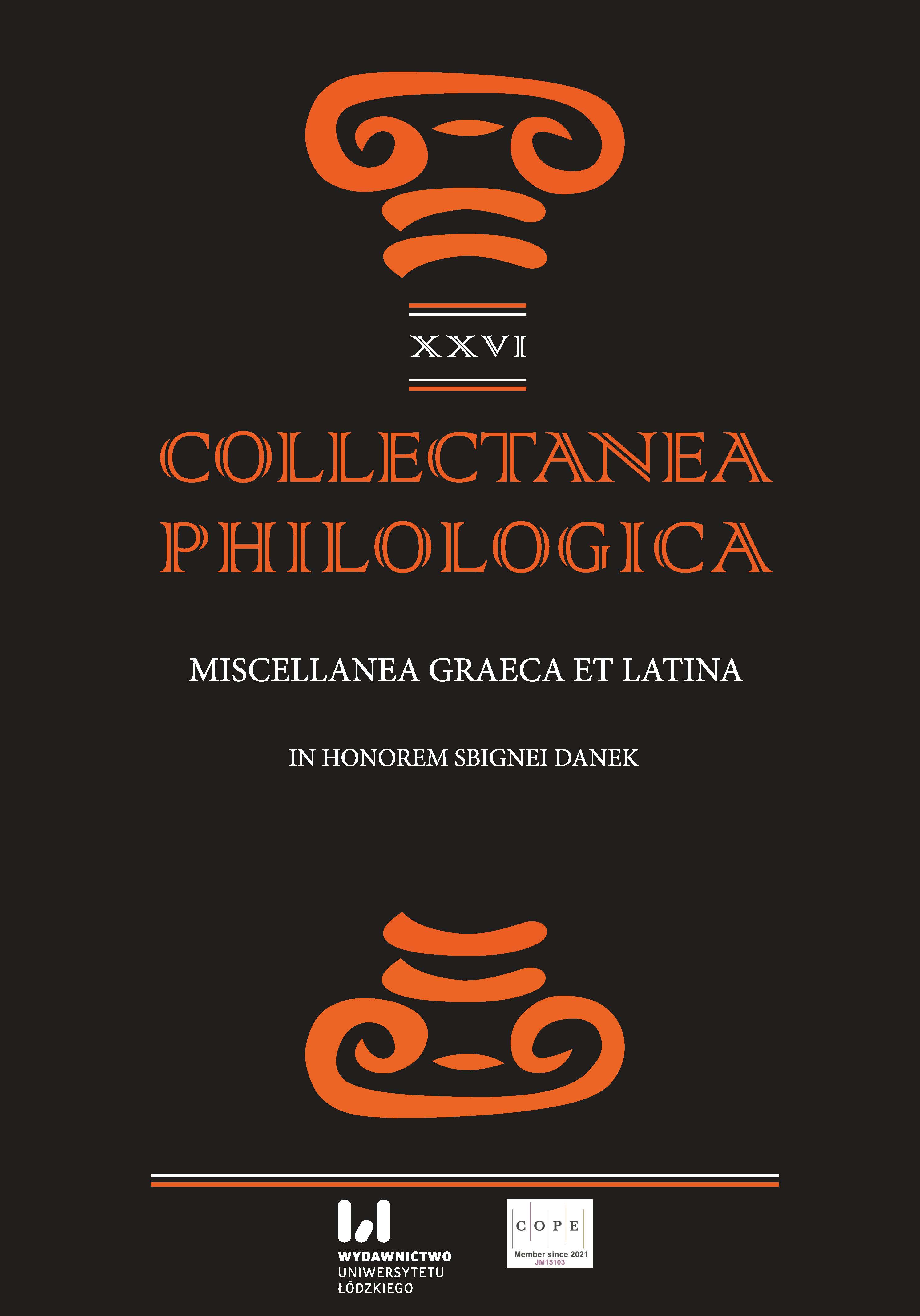The Motif of Arboreal Metamorphosis in the Neo-Latin Pastoral. The Case Study of Jacopo Sannazaro’s Salices and Pierre-Daniel Huet’s Vitis
DOI:
https://doi.org/10.18778/1733-0319.26.16Słowa kluczowe:
bukolika nowołacińska, metamorfoza, Jacopo Sannazaro, Salices, Pierre-Daniel HuetAbstrakt
The aim of this article is to analyse two examples of the motif of arboreal metamorphosis in the Neo-Latin bucolic, present in the poems by Jacopo Sannazaro (Salices) and Pierre-Daniel Huet (Vitis). In Salices, nymphs fleeing from the deities are transformed into willows, repeting the fate of Ovid’s Daphne, Syrinx and the Heliades. In Vitis the poet creates a story about a nymph, named Vitis, on the basis of the love story of the satyr Ampelos and Dionysus. For betraying Bacchus, she is turned into a vine and her lover Ulmus into an elm. Their fate is similar to Ovid’s Myrrha and Philemon and Baucis. In the history of Vitis, particularly in the description of the lovers’ metamorphosis, one can see borrowings from Sannazaro. Both bucolic poems are linked by the ambiguity of the ontological status of the newly created plants. They differ in their moral interpretation of metamorphosis. The turning of the nymphs into trees can be understood as some kind of punishment for the rape that had been committed on them. On the other hand, Vitis, who committed treachery, is in fact rewarded and by the will of Jupiter she remains united with her lover forever.
Bibliografia
Borghini, V. (1943). Il più nobile umanista del rinascimento. Torino: Sei.
Google Scholar
Curran, L.C. (1978). “Rape and Rape Victims in the Metamorphoses”. Arethusa 11. 213–241.
Google Scholar
Cytowska, M. (1962). “O Wierzbach Szymonowica na nowo”. Meander 17. 276–278.
Google Scholar
Fairclough, H.R., Goold, G.P., Virgil. (1916). Eclogues, Georgics, Aeneid: Books 1–6. Cambridge, MA: Harvard University Press.
Google Scholar
Fallon, P., Fantham, E., Virgil. (2006). Georgics. Oxford: Oxford University Press.
Google Scholar
Feldherr, A. (2006). Metamorphosis in the “Metamorphoses”. In: Ph. Hardie (ed.). The Cambridge Companion to Ovid. Cambridge: Cambridge University Press. 163–179.
Google Scholar
Grant, W.L. (1965). Neo–Latin Literature and the Pastoral. Chapel Hill: University of North Carolina Press.
Google Scholar
Hett, W.S., Aristotle. (1955). Aristotle: Minor Works. Cambridge, MA, London: Harvard University Press, William Heinemann Ltd.
Google Scholar
Hubbard, Th. (1998). The Pipes of Pan: Intertextuality and Literary Filiation in the Pastoral Tradition from Theocritus to Milton. Ann Arbor: University of Michigan Press.
Google Scholar
Huetius, P.D. (1694). Petri Danielis Huetii Poemata Latina & Graeca quotquot colligi potuerunt. Trajecti ad Rhenum: ex officina Guillelmi Broedelet.
Google Scholar
Huetius, P.D. (1712). Dissertations sur diverses matières de religion et de philologie… Paris: François Fournier Libraire.
Google Scholar
Kelley, Sh. (2019). Women in Trees: Adapting Ovid for John Lyly’s “Love’s Metamorphosis” (1589). In: L.S. Starks, (ed.). Ovid and Adaptation in Early Modern English Theatre. Edinburgh: Edinburgh University Press. 39–56. https://doi.org/10.3366/edinburgh/9781474430067.003.0003.
Google Scholar
Kennedy, J. (1983). Jacopo Sannazaro and the Uses of Pastoral. Hanover, London: University Press of New England.
Google Scholar
Ovid. (1931). Heroides and Amores. Trans. G. Showerman. Cambridge, MA: Harvard University Press.
Google Scholar
Ovid. (2004). Metamorphoses. Trans. Ch. Martin. New York, London: W.W. Norton & Co.
Google Scholar
Ovid. (2013). Fasti. A. Wiseman, P. Wiseman (eds.). Oxford: Oxford University Press.
Google Scholar
Peters, Ch. (2018). Founding Sisters: Nymphs and Aetiology in Humanist Latin Poetry. In K.A.E. Enenkel (ed.). The Figure of the Nymph in Early Modern Culture. Leiden, Boston: Brill. 421–444.
Google Scholar
Putnam, M., Sannazaro J. (2009). Jacopo Sannazaro: Latin Poetry. Cambridge, MA: Harvard University Press.
Google Scholar
Salemme, C. (2018). Le “metamorfosi” del Sannazaro. Bari: Cacuccio Editore.
Google Scholar
Sannazaro, J., Nash, R. (1996). The Major Latin Poems of Jacopo Sannazaro. Detroit: Wayne State University Press.
Google Scholar
Sharrock, A. (2006). Gender and Sexuality. In: Ph. Hardie (ed.). The Cambridge Companion to Ovid. Cambridge: Cambridge University Press. 95–107.
Google Scholar
Shelford, A.G. (2006). Transforming the Republic of Letters. Pierre-Daniel Huet and European Intellectual Life, 1650–1720. New York: Boydell & Brewer.
Google Scholar
Veres, O. (2019). “Spaces in Between in the Myth of Myrrha: A Metamorphosis into Tree”. Acta Universitatis Sapientiae Philologica 11. 83–92.
Google Scholar
Zamir, T. (2011). “Talking trees”. New Literary History 41. 439–453.
Google Scholar
Zatta, C. (2016). “Plants’ Interconnected Lives: from Ovid’s Myths to Presocratic Thought and Beyond”, Arion 24. 101–126.
Google Scholar
Pobrania
Opublikowane
Wersje
- 2023-12-08 - (2)
- 2023-10-05 - (1)
Jak cytować
Numer
Dział
Licencja

Utwór dostępny jest na licencji Creative Commons Uznanie autorstwa – Użycie niekomercyjne – Bez utworów zależnych 4.0 Międzynarodowe.












